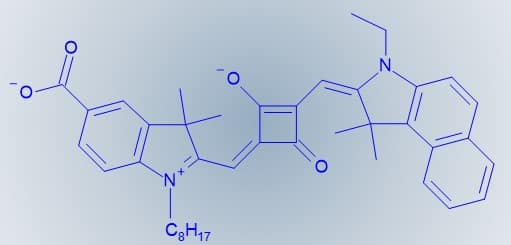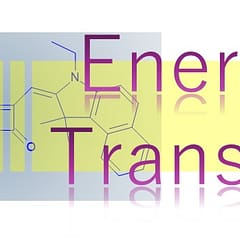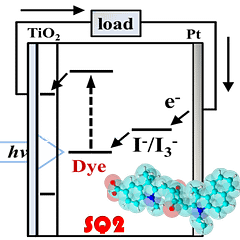やさしく解説:SQ2色素とは?— DSSC(色素増感太陽電池)を深い赤で強くする【日本語版】
作成日:2025-11-01 / 対象:一般向け解説
まずは1分で
- SQ2 は スクアライン系(squaraine) の有機色素。深い赤〜近赤外をよく吸収します。
- **DSSC(色素増感太陽電池)**では、チタン酸化物(TiO₂)の表面に カルボン酸基などで“くっつき”、光を電気に変える「受光アンテナ」になります。
- SQ2 は 可視〜近赤外の光取り込みを拡張できる一方、**分子が寄り集まる(凝集)**と性能が落ちやすいので、共吸着剤や共増感の工夫がコツです。
DSSCのしかけ(やさしく)
- 光を吸収:SQ2 が光を受けて励起します。
- 電子注入:励起した電子が TiO₂ の伝導帯へ飛び込みます。
- 回路へ:電子は外部回路を流れて電力に。
- 再生:電解質(ヨウ素系/コバルト系など)が SQ2 を元の状態に戻すことで、次の発電サイクルが続きます。
SQ2 は 深い赤に強いので、可視の青〜緑が得意な他色素と組ませると、光の“穴”を埋めて総合力アップが期待できます。
SQ2 が選ばれる理由
- 広い吸収:可視後半〜近赤外を強く吸収 → 短絡電流密度(Jsc)の底上げに寄与。
- プッシュ–プル設計:電子供与部と受容部を持つ**分子内電荷移動(ICT)**型で、電子注入がスムーズ。
- 固定化が容易:カルボン酸基などのアンカーで TiO₂ にしっかり結合。
実験で効かせる3つのコツ
1) 凝集(H/J会合)を止める
- 共吸着剤(例:CDCA など)を少量加えると、SQ2 同士の密な並びを抑制し、吸収の歪みや電荷移動のロスを軽減します。
2) 共増感(コセンサタイゼーション)で“波長の穴”を埋める
- 可視の青〜緑が強い色素(ポルフィリン、ルテニウム系、有機ドナー–アクセプター色素など)と 組み合わせ塗布。
- 光取り込みの足し算で Jsc の改善が狙えます。
3) 電解質とマッチング
- 酸化還元電位の合う電解質(ヨウ素系 / コバルト錯体系など)を選び、開放電圧Vocと再結合抑制のバランスを最適化。
- **添加剤(TBP、Li⁺塩)**で界面準位・拡散を微調整。
よくある質問(FAQ)
Q1. SQ2 はなぜ近赤外に強いの?
→ スクアリン核による強い電荷移動と共役系が、低エネルギー(長波長)での吸収を可能にします。
Q2. 退色や安定性は大丈夫?
→ 光・熱・酸素で劣化する可能性はあります。分子設計(置換基)・膜内環境(疎水化)・封止で耐久性を向上させます。
Q3. まず何から試す?
→ (i)SQ2 濃度は“濃すぎ注意”、(ii)CDCA 等の共吸着剤を 1–3 mM レンジでスクリーニング、(iii)共増感の相方に可視短波長に強い色素を選定。
参考・キーワード
- キーワード:squaraine dye, SQ2, DSSC, co-sensitization, aggregation control, CDCA, TiO₂ anchoring
Gentle Guide: What is SQ2? — Deep-Red Squaraine Dyes for DSSCs【English Version】
Updated: 2025-11-01 / For general readers
In one minute
- SQ2 is a squaraine organic dye that absorbs deep red to near-infrared light.
- In dye-sensitized solar cells (DSSCs), it anchors to TiO₂ (via carboxylic acid groups, etc.) and acts as a light-harvesting antenna.
- SQ2 can extend spectral coverage but may aggregate; use co-adsorbents and co-sensitization to get stable, higher output.
DSSC basics (plain language)
- Absorb: SQ2 catches light and gets excited.
- Inject: The excited electron is injected into TiO₂.
- Flow: Electrons travel through the circuit to do work.
- Regenerate: The electrolyte restores SQ2 for the next cycle.
Because SQ2 excels in the red–NIR, pairing it with a blue/green-strong dye often fills spectral gaps and lifts overall current.
Why SQ2?
- Broad, red-shifted absorption → potential Jsc gains.
- Push–pull (ICT) architecture aids fast electron injection.
- Robust anchoring to TiO₂ via carboxylate groups.
Three lab tips
1) Tame aggregation (H/J)
Add a co-adsorbent (e.g., CDCA) to keep SQ2 molecules apart, preserving spectral shape and charge transfer.
2) Co-sensitize to cover the spectrum
Load a complementary dye (porphyrin, Ru-complex, or organic D–A dyes with blue–green strength) to sum the absorption and raise Jsc.
3) Match the electrolyte
Choose redox couples (iodide/triiodide or cobalt complexes) that fit your energy levels, and tune Voc/recombination with TBP, Li⁺, etc.
FAQs
Why does SQ2 reach the NIR?
The squaraine core and extended π-conjugation enable strong ICT transitions at lower energies.
What about stability?
Design substituents, control micro-environment, and use proper encapsulation to mitigate photo-/thermal-oxidative degradation.
Where to start?
(i) Avoid over-dense loading; (ii) screen co-adsorbent (1–3 mM); (iii) pick a blue-green partner dye for co-sensitization.
References & keywords
- Keywords: SQ2, squaraine dye, DSSC, co-sensitization, aggregation control, TiO₂ anchoring
- (Add specific DOIs from your curated list when publishing.)



